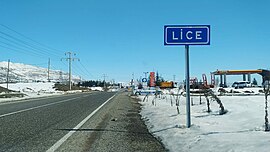
Summary
Lice (pronounced [ˈlidʒe]), (Kurdish: Licê,[2] Ottoman Turkish: ليجه,[3]) is a municipality and district of Diyarbakır Province, Turkey.[4] Its area is 982 km2,[5] and its population is 24,364 (2022).[1] It is located 90 km (56 mi) from the capital, Diyarbakır. Its population is Kurdish.[6] In the local elections in March 2019 Tarık Mercan from the Peoples' Democratic Party (HDP) was elected mayor.[7] The current District Governor is Muhammed Evlice.[8]
Lice | |
|---|---|
District and municipality | |
 | |
 Map showing Lice District in Diyarbakır Province | |
 Lice Location in Turkey | |
| Coordinates: 38°27′0″N 40°39′0″E / 38.45000°N 40.65000°E | |
| Country | Turkey |
| Province | Diyarbakır |
| Area | 982 km2 (379 sq mi) |
| Population (2022)[1] | 24,364 |
| • Density | 25/km2 (64/sq mi) |
| Time zone | UTC+3 (TRT) |
| Postal code | 21700 |
| Area code | 0412 |
| Website | www |
History edit
Lice was the headquarters of the 5th Army Corps of the Turkish army during the Sheikh Said rebellion in 1925[9] and it was a focal point at the beginning of the rebellion. The town was captured on the 20 February by the troops loyal to Sheikh Said.[10] The Kurdish Zirki tribe in the Lice district also supported the Sheik Said rebellion and as a reprisal, the tribes villages Çaylarbaşı, Kurlu, Alataş, Mat-bur and Çağlayan have been demolished and the residing population was killed by troops of the Turkish army.[11] It was reported that the troops of the Turkish Major Ali Haydar have wiped out the majority of the Sheikhs.[12]
On 6 September 1975, Lice was struck by an earthquake with a magnitude of Ms 6.7. Around 1.500 people were killed in Lice according to the mayor.[13]
The Kurdistan Workers' Party or PKK, was founded in the village of Fîs, in Lice district on November 27, 1978.[14]
The Lice massacre, during which the Turkish army demolished large parts of the town in reprisal of the death of an Jandarma officer, took place from October 20–23, 1993.[15]
Between 2018 and 2019 localities in the Lice district have often been targeted with curfews declared by the Turkish authorities, which wanted to execute security operations in the district.[16][17][18]
The Kurdish castle of Ataq used to exist near the modern Lice.
Demographics edit
In 1914, 5,980 Armenians and 4,100 Assyro-Chaldeans lived in the kaza. Armenians had 24 churches, one monastery and five schools. Lice proper had 12,000 inhabitants, including 7,000 Christians (Armenians, Chaldean, Syriac Orthodox).[19] During the Armenian genocide, all males were massacred, women and children were deported and their fate is unknown.[19]
Composition edit
There are 70 neighbourhoods in Lice District:[20]
- Abalı
- Akçabudak
- Arıklı
- Bağlan
- Baharlar
- Bayırlı
- Birlik
- Budak
- Çağdaş
- Cami Kebir
- Çarşı
- Çavundur
- Çeper
- Çıralı
- Dallıca
- Damar
- Daralan
- Delvan
- Dernek
- Dibekköy
- Dolunay
- Duruköy
- Ecemiş
- Erginköy
- Esenler
- Gökçe
- Güçlü
- Güldiken
- Gürbeyli
- Hedik
- Kabakaya
- Kalı
- Karahasan
- Kelvan
- Kılıçlı
- Kıpçak
- Kıralan
- Kıyıköy
- Körtük
- Kumluca
- Kutlu
- Mulla
- Müminağa
- Muradiye
- Ortaç
- Örtülü
- Oyuklu
- Şaar
- Savat
- Saydamlı
- Şenlik
- Serince
- Sığınak
- Tepe
- Türeli
- Tuzlaköy
- Uçarlı
- Üçdamlar
- Ulucak
- Yalaza
- Yalımlı
- Yamaçlı
- Yaprakköy
- Yenişehir
- Yeşilburç
- Yolçatı
- Yorulmaz
- Yünlüce
- Ziyaret
- Zümrüt
References edit
- ^ a b "Address-based population registration system (ADNKS) results dated 31 December 2022, Favorite Reports" (XLS). TÜİK. Retrieved 12 July 2023.
- ^ Malmîsanij, Mehemed (1989). Pîro; Baran; Şêxbizinî (eds.). "Bazı yörelerde Dımıli ve Kurmanci lehçelerinin köylere göre dağılımı - III -". Berhem (in Turkish). 4: 54. ISSN 1100-0910.
- ^ Tahir Sezen, Osmanlı Yer Adları (Alfabetik Sırayla), T.C. Başbakanlık Devlet Arşivleri Genel Müdürlüğü, Yayın Nu 21, Ankara, p. 340.
- ^ Büyükşehir İlçe Belediyesi, Turkey Civil Administration Departments Inventory. Retrieved 12 July 2023.
- ^ "İl ve İlçe Yüz ölçümleri". General Directorate of Mapping. Retrieved 12 July 2023.
- ^ Lokman I. Meho, Kelly L. Maglaughlin (2001). Kurdish Culture and Society: An Annotated Bibliography. Bloomsbury Publishing USA. p. 248. ISBN 9780313016806.
- ^ "Diyarbakır Lice Seçim Sonuçları - 31 Mart 2019 Yerel Seçimleri". www.sabah.com.tr. Retrieved 2019-09-09.
- ^ "Kaymakam Muhammed Evlice". Lice Kaymakamlığı. Retrieved 29 August 2023.
- ^ Olson, Robert (1989). The Emergence of Kurdish Nationalism and the Sheikh Said Rebellion, 1880–1925. University of Texas Press. p. 42. ISBN 0292776195.
- ^ Olson, Robert (1989). p.102
- ^ Üngör, Uğur Ümit (2012). Jorngerden, Joost; Verheij, Jelle (eds.). Social Relations in Ottoman Diyarbekir, 1870-1915. Brill. p. 289. ISBN 9789004225183.
- ^ Üngör, Umut. "Young Turk social engineering : mass violence and the nation state in eastern Turkey, 1913- 1950" (PDF). University of Amsterdam. p. 238. Retrieved 9 April 2020.
- ^ "Partial recovery and reconstruction after disaster: the Lice case" (PDF). 1977. pp. 235–236. Archived from the original (PDF) on 2011-07-27.
- ^ Turkey-PKK peace process unravels in Lice by Cengiz Çandar in Al Monitor (9 June 2014)
- ^ Ron, James (1995). Weapons Transfers and Violations of the Laws of War in Turkey. Human Rights Watch. pp. 120–121. ISBN 9781564321619.
- ^ "Curfew in Lice". Bianet. 12 February 2019. Retrieved 12 September 2020.
- ^ "Curfew in Lice". Bianet. 24 December 2018. Retrieved 12 September 2020.
- ^ "Curfew in Lice in Diyarbakır". Bianet. 26 November 2018. Retrieved 12 September 2020.
- ^ a b "Kaza Lice / ܠܓܗ - Leggeh (mlaḥso: lago) / lige". Virtual Genocide Memorial. Retrieved 2023-09-18.
- ^ Mahalle, Turkey Civil Administration Departments Inventory. Retrieved 12 July 2023.


